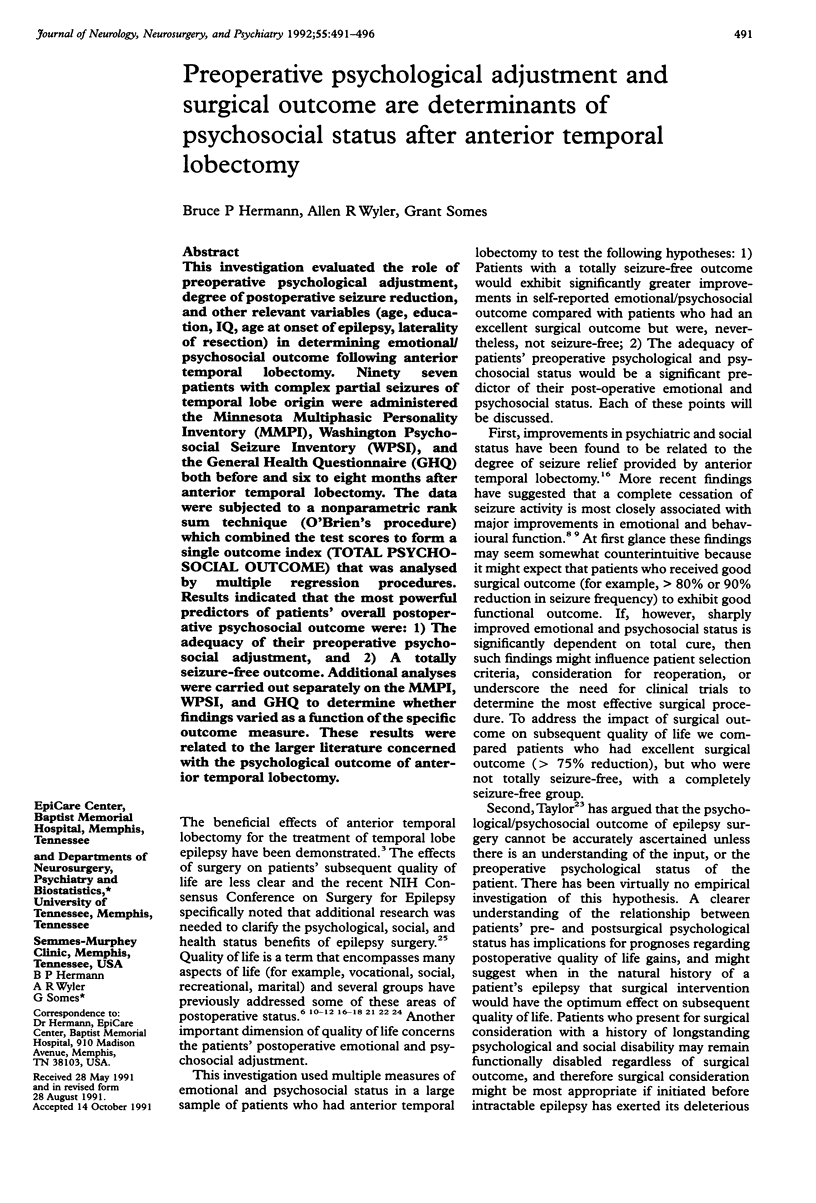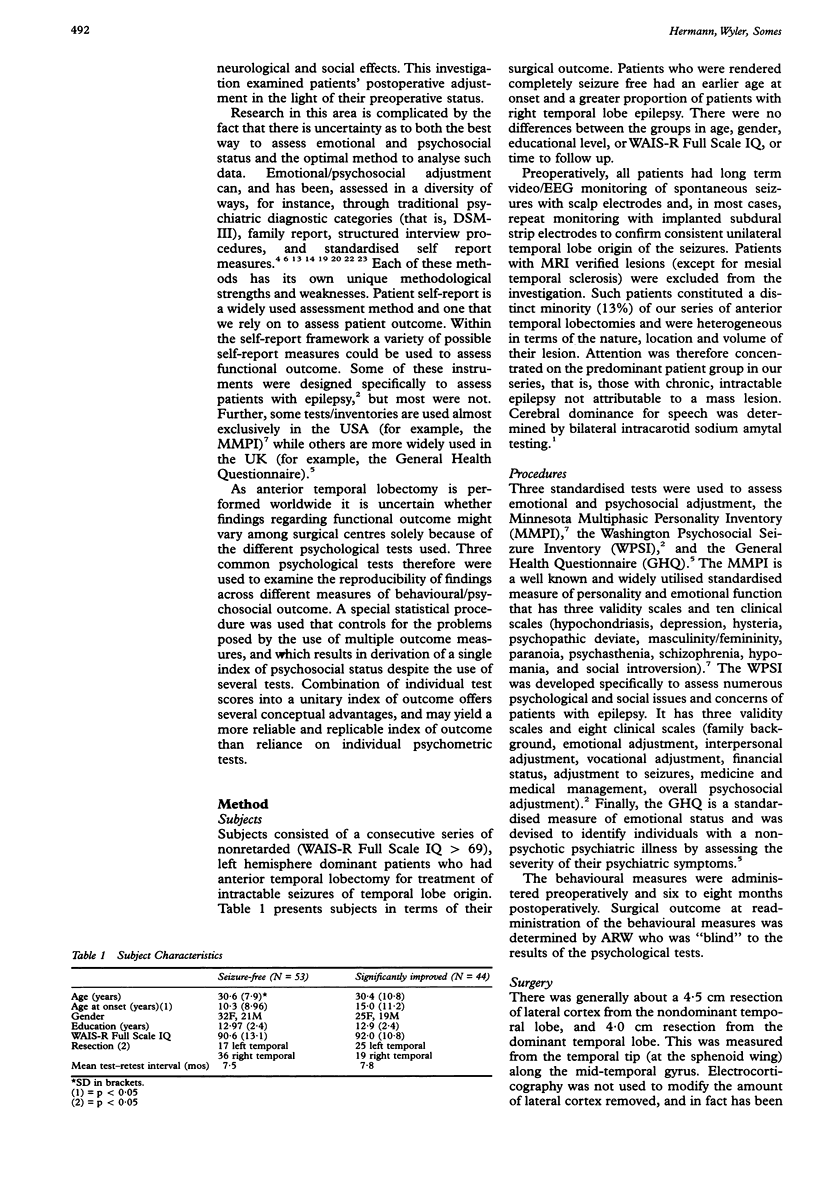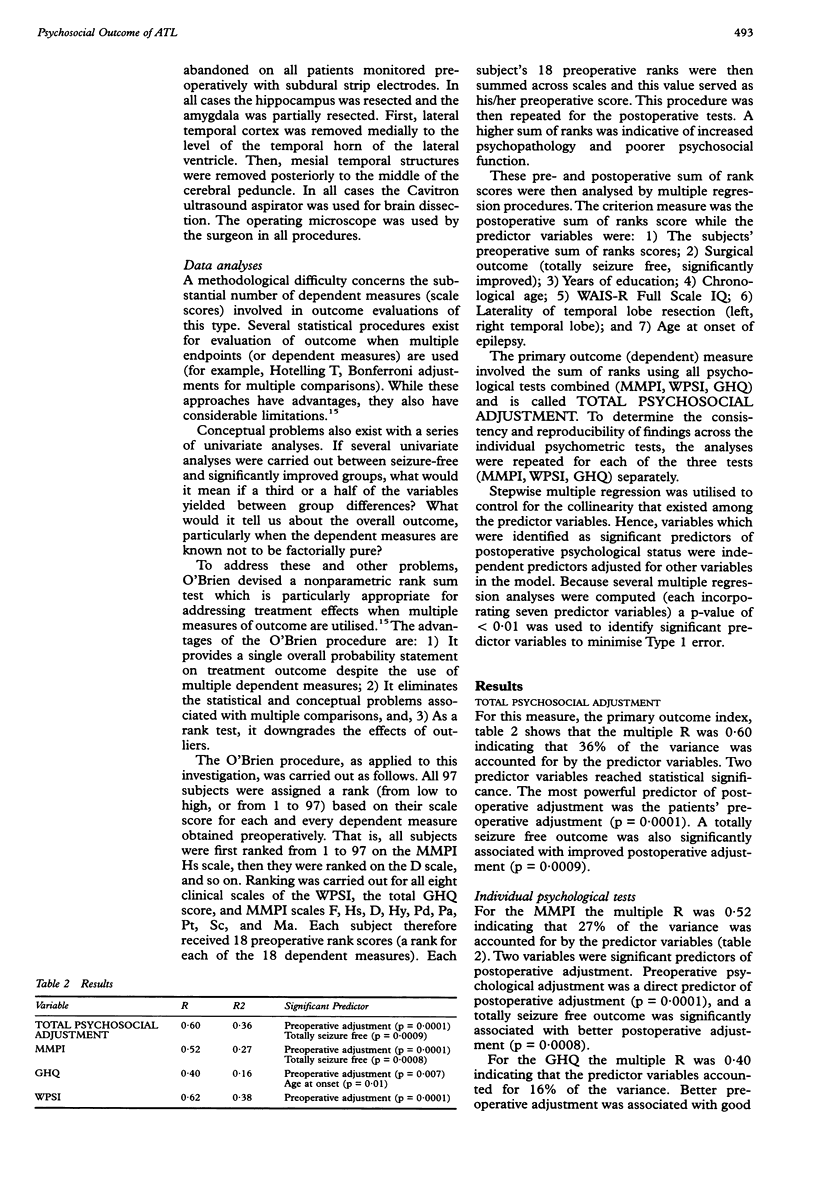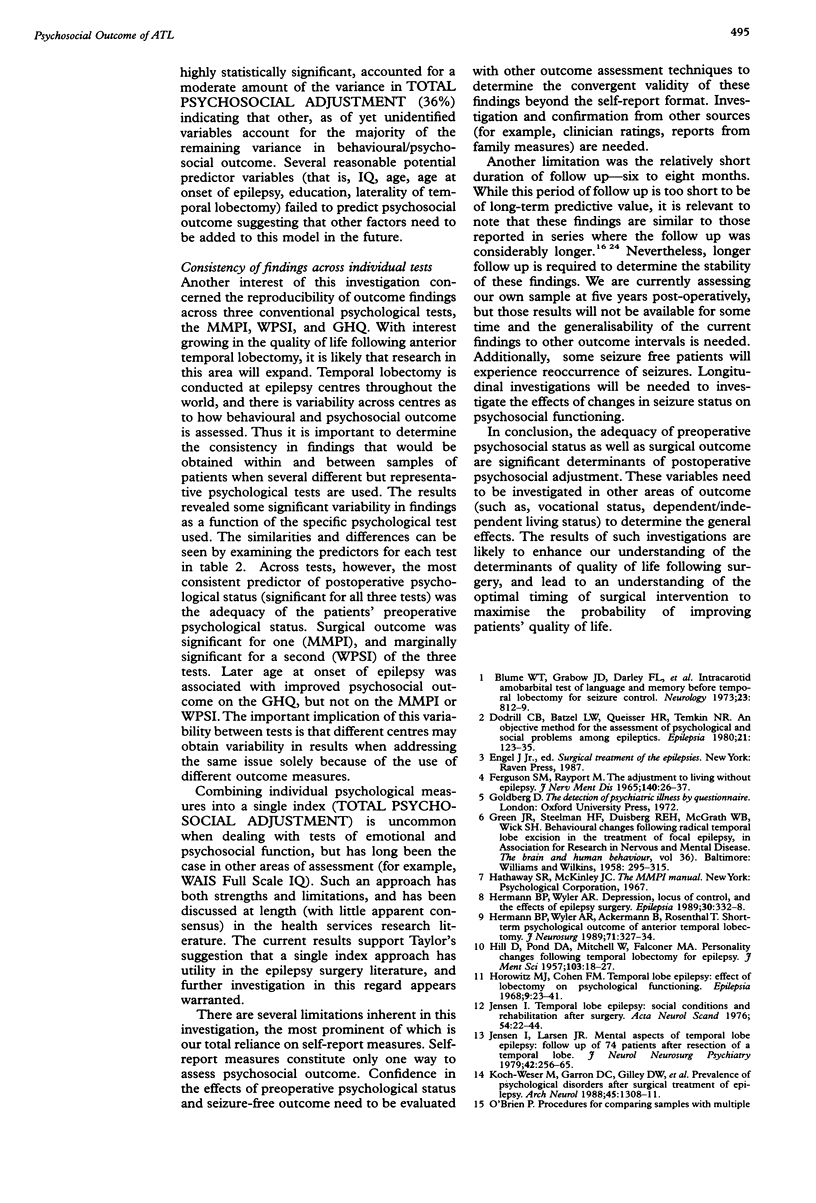Abstract
This investigation evaluated the role of preoperative psychological adjustment, degree of postoperative seizure reduction, and other relevant variables (age, education, IQ, age at onset of epilepsy, laterality of resection) in determining emotional/psychosocial outcome following anterior temporal lobectomy. Ninety seven patients with complex partial seizures of temporal lobe origin were administered the Minnesota Multiphasic Personality Inventory (MMPI), Washington Psychosocial Seizure Inventory (WPSI), and the General Health Questionnaire (GHQ) both before and six to eight months after anterior temporal lobectomy. The data were subjected to a nonparametric rank sum technique (O'Brien's procedure) which combined the test scores to form a single outcome index (TOTAL PSYCHOSOCIAL OUTCOME) that was analysed by multiple regression procedures. Results indicated that the most powerful predictors of patients' overall postoperative psychosocial outcome were: 1) The adequacy of their preoperative psychosocial adjustment, and 2) A totally seizure-free outcome. Additional analyses were carried out separately on the MMPI, WPSI, and GHQ to determine whether findings varied as a function of the specific outcome measure. These results were related to the larger literature concerned with the psychological outcome of anterior temporal lobectomy.
Full text
PDF





Selected References
These references are in PubMed. This may not be the complete list of references from this article.
- Blume W. T., Grabow J. D., Darley F. L., Aronson A. E. Intracarotid amobarbital test of language and memory before temporal lobectomy for seizure control. Neurology. 1973 Aug;23(8):812–819. doi: 10.1212/wnl.23.8.812. [DOI] [PubMed] [Google Scholar]
- Dodrill C. B., Batzel L. W., Queisser H. R., Temkin N. R. An objective method for the assessment of psychological and social problems among epileptics. Epilepsia. 1980 Apr;21(2):123–135. doi: 10.1111/j.1528-1157.1980.tb04053.x. [DOI] [PubMed] [Google Scholar]
- FERGUSON S. M., RAYPORT M. THE ADJUSTMENT TO LIVING WITHOUT EPILEPSY. J Nerv Ment Dis. 1965 Jan;140:26–37. doi: 10.1097/00005053-196501000-00003. [DOI] [PubMed] [Google Scholar]
- HILL D., POND D. A., MITCHELL W., FALCONER M. A. Personality changes following temporal lobectomy for epilepsy. J Ment Sci. 1957 Jan;103(430):18–27. doi: 10.1192/bjp.103.430.18. [DOI] [PubMed] [Google Scholar]
- Hermann B. P., Wyler A. R., Ackerman B., Rosenthal T. Short-term psychological outcome of anterior temporal lobectomy. J Neurosurg. 1989 Sep;71(3):327–334. doi: 10.3171/jns.1989.71.3.0327. [DOI] [PubMed] [Google Scholar]
- Hermann B. P., Wyler A. R. Depression, locus of control, and the effects of epilepsy surgery. Epilepsia. 1989 May-Jun;30(3):332–338. doi: 10.1111/j.1528-1157.1989.tb05306.x. [DOI] [PubMed] [Google Scholar]
- Horowitz M. J., Cohen F. M. Temporal lobe epilepsy: effect of lobectomy on psychosocial functioning. Epilepsia. 1968 Mar;9(1):23–41. doi: 10.1111/j.1528-1157.1968.tb04955.x. [DOI] [PubMed] [Google Scholar]
- Jensen I., Larsen J. K. Mental aspects of temporal lobe epilepsy. Follow-up of 74 patients after resection of a temporal lobe. J Neurol Neurosurg Psychiatry. 1979 Mar;42(3):256–265. doi: 10.1136/jnnp.42.3.256. [DOI] [PMC free article] [PubMed] [Google Scholar]
- Jensen I. Temporal lobe epilepsy. Social conditions and rehabilitation after surgery. Acta Neurol Scand. 1976 Jul;54(1):22–44. doi: 10.1111/j.1600-0404.1976.tb07618.x. [DOI] [PubMed] [Google Scholar]
- Koch-Weser M., Garron D. C., Gilley D. W., Bergen D., Bleck T. P., Morrell F., Ristanovic R., Whisler W. W., Jr Prevalence of psychologic disorders after surgical treatment of seizures. Arch Neurol. 1988 Dec;45(12):1308–1311. doi: 10.1001/archneur.1988.00520360026006. [DOI] [PubMed] [Google Scholar]
- O'Brien P. C. Procedures for comparing samples with multiple endpoints. Biometrics. 1984 Dec;40(4):1079–1087. [PubMed] [Google Scholar]
- Rausch R., Crandall P. H. Psychological status related to surgical control of temporal lobe seizures. Epilepsia. 1982 Apr;23(2):191–202. doi: 10.1111/j.1528-1157.1982.tb05067.x. [DOI] [PubMed] [Google Scholar]
- Rausch R., McCreary C., Crandall P. H. Psychosocial functioning following successful surgical relief from seizures. Evidence of prediction from preoperative personality characteristics. J Psychosom Res. 1977;21(2):141–146. doi: 10.1016/0022-3999(77)90081-2. [DOI] [PubMed] [Google Scholar]
- SERAFETINIDES E. A. AGGRESSIVENESS IN TEMPORAL LOBE EPILEPTICS AND ITS RELATION TO CEREBRAL DYSFUNCTION AND ENVIRONMENTAL FACTORS. Epilepsia. 1965 Mar;6:33–42. doi: 10.1111/j.1528-1157.1965.tb03348.x. [DOI] [PubMed] [Google Scholar]
- Taylor D. C., Falconer M. A. Clinical, socio-economic, and psychological changes after temporal lobectomy for epilepsy. Br J Psychiatry. 1968 Oct;114(515):1247–1261. doi: 10.1192/bjp.114.515.1247. [DOI] [PubMed] [Google Scholar]


